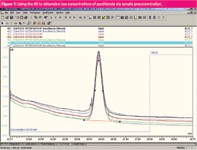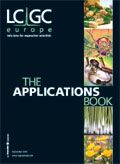Precise Sample Preconcentration Coupled with Automated Sampling
The Application Notebook
Dionex has developed an autosampler with very precise sample preconcentration capabilities. When analyte detection is no longer possible even with a large loop injection, sample preconcentration (loading a sample through a concentrator column and eluting the concentrate) is used.
Dionex has developed an autosampler with very precise sample preconcentration capabilities. When analyte detection is no longer possible even with a large loop injection, sample preconcentration (loading a sample through a concentrator column and eluting the concentrate) is used. Although sample preconcentration is not new, the challenge has been to match an appropriate concentrator pump with the accuracy requirement of the application and fully automate the process. As detection limits are reduced, non-reproducibility of the pumping mechanism can lead to significant error and a high relative standard deviation for the analyte of interest. The Dionex AS uniquely pairs a very highly precise syringe pump with the capabilities of an autosampler to allow sample preconcentration in an automated fashion for up to 49 samples.
The "concentrate" feature on the new AS allows the user to concentrate up to 8 mL of sample with full automation capability. The actual "concentrate" step uses the same mechanism that the autosampler uses to make traditional sample loop injections, albeit with a considerably higher volume than loop loading. With "concentrate", sample is loaded onto a concentrator column (up to 150 psi backpressure) and RSDs of below 0.5% are routinely achieved. The precision is related to the volume delivered, flow-rate across the concentrator and the capacity of the concentrator. The AS syringe pump is able to deliver precise, repeatable volumes onto the concentrator despite possible changes in backpressure. Figure 1 illustrates the use of the AS in determining low concentrations of perchlorate (5 ppb) via sample preconcentration. In this example, 5 mL of sample were injected over a concentrator column (TAC-ULP) to achieve the desired detection limits. RSDs for perchlorate at this concentration are less than 1%.

Figure 1: Using the AS to determine low concentrations of perchlorate via sample preconcentration.
Conclusion
With the Dionex AS, chromatographers now have automated sample preconcentration without the need to manually feed sample into a pump. This translates to direct labour savings as well as improved analysis reliability.
New Method Explored for the Detection of CECs in Crops Irrigated with Contaminated Water
April 30th 2025This new study presents a validated QuEChERS–LC-MS/MS method for detecting eight persistent, mobile, and toxic substances in escarole, tomatoes, and tomato leaves irrigated with contaminated water.
Accelerating Monoclonal Antibody Quality Control: The Role of LC–MS in Upstream Bioprocessing
This study highlights the promising potential of LC–MS as a powerful tool for mAb quality control within the context of upstream processing.
University of Tasmania Researchers Explore Haloacetic Acid Determiniation in Water with capLC–MS
April 29th 2025Haloacetic acid detection has become important when analyzing drinking and swimming pool water. University of Tasmania researchers have begun applying capillary liquid chromatography as a means of detecting these substances.

.png&w=3840&q=75)

.png&w=3840&q=75)



.png&w=3840&q=75)



.png&w=3840&q=75)







